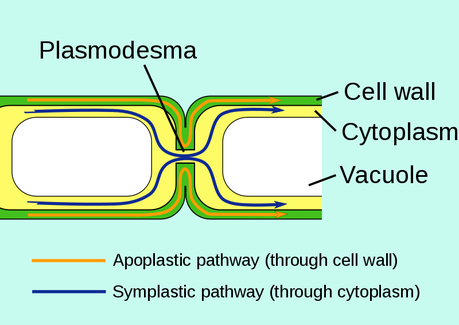The Major Difference Between Symplast and Vacuolar Pathway is that in the symplast pathway, water does not enter into vacuoles while in the vacuolar pathway, water passes into vacuoles.
Both the pathways are involved in the movement of water across the root. Water flows via Apoplast in the cortex. It enters the Symplast pathway in the endodermis where walls are impervious to flow of water due to the presence of casparian strips.
Therefore, water does not cross any membrane or cytoplasm in the apoplast pathway. In the symplast pathway, water moves through protoplasm from the cytoplasm to cytoplasm via plasmodesmata, so water does not enter into vacuoles in the symplast pathway. In the vacuolar pathway, water moves through the plasma membrane, cytoplasm, and then through the vacuole.
Apoplast and symplast are two separate pathways in plants that initiate the passage of water along with ions from root hair via the root cortex to xylem elements. These routes may exist either simultaneously or separately having different rates.
What is Symplast Pathway?
Symplast pathway is one of the three main routes of water movement in plants. In the symplast pathway, water moves from cytoplasm to cytoplasm via the plasmodesmata. Therefore, water does not cross the tonoplast or vacuoles of the cells. The water movement via the symplast pathway takes place by osmosis. And, this pathway uses the protoplasm of the cell.

Figure 01: Symplast Pathway
Moreover, this is one of the main pathways by which water and nutrients reach the xylem of the plant from the soil via roots. Water moves freely through this pathway. Also, low molecular weight solutes such as sugars, amino acids, and ions move between cells.
What You Need To Know About Symplast
- Symplast refers to the continuous arrangement of protoplasts of a plant, which are interconnected by plasmodesmata.
- Symplast consists of protoplasts.
- Symplast is composed of living parts of a plant.
- In Symplast, the water movement occurs by osmosis.
- In Symplast, the water movement is slower.
- The metabolic rate of the cells in the root cortex highly affects the water movement.
- It shows some little resistance to the water movement.
- Beyond the cortex, water moves through the Symplast.
- It is aided by streaming movements of cytoplasm.
What is Vacuolar Pathway?
The vacuolar pathway is another route of water movement through plant cells. In the vacuolar pathway, water moves through the protoplasm. In other words, the water movement takes place via the cell walls, plasma membrane, cytoplasm, tonoplast, and central vacuole. Since water passes through several parts of the plant cell in the vacuolar pathway, it provides a lot of resistance. Hence, it is not commonly used. It is used only when individual cells uptake water from the surrounding.
What are the Similarities Between Symplast and Vacuolar Pathway?
- Symplast and vacuolar pathways are two of the three main types of water movement pathways through plant cells.
- In both pathways, water passes through the cytoplasm of the cell.
- Water moves by osmosis in both pathways.
What is the Difference Between Symplast and Vacuolar Pathway?
Symplast pathway is the movement of water molecules via the cytoplasms of plant cells while the vacuolar pathway is the movement of water molecules via the central vacuoles of plant cells. Therefore, in the symplast pathway, water does not enter the vacuoles while in the vacuolar pathway, water passes through central vacuoles. So, this is the key difference between the symplast and vacuolar pathway.
Moreover, water moves from cytoplasm to cytoplasm via plasmodesmata in the symplast pathway. In contrast, water moves through the cell wall, plasma-lemma, cytoplasm, tonoplast and central vacuole in the vacuolar pathway. However, due to the high resistance posed by the vacuolar pathway, it is only used when individual cells uptake water. But, the symplast pathway is commonly used by plants for the water movements.
Below is a tabulation of the difference between symplast and vacuolar pathway.

Summary – Symplast vs Vacuolar Pathway
Symplast and vacuolar pathways are two of the three pathways by which water moves in plant cells. In the symplast pathway, water moves from the cytoplasm of one cell to the cytoplasm of the next cell through plasmodesmata.
In the vacuolar pathway, water moves between vacuoles of cells crossing cytoplasms as well. Compared to the vacuolar pathway, the resistance is less in the symplast pathway, and plant cells use this pathway more frequently than the vacuolar pathway. Thus, this summarizes the difference between symplast and vacuolar pathway.
Frequently Asked Questions
What do you mean by the apoplast pathway?
In the apoplast pathway, the water moves through the adjacent wall of the epidermis and cortex without entering the cytoplasm.
What is an apoplast?
The apoplast is the system of adjacent, continuous cell walls. It refers to the space outside the plasma membrane within which the molecules can freely diffuse.
Is apoplast active or passive absorption?
The apoplast is the passive absorption that takes place through the apoplast of the root that comprises cell walls and intercellular spaces.
What is the importance of the Casparian strip?
Casparian strip is a band of waterproof tissue found on the side walls of the endodermis of roots. The strip prevents water from entering the pericycle that is important in inducing root pressure.
Reference:
1. “Movement Of Water In Roots: 3 Pathways (With Diagram)”. Biology Discussion, 2020, Available here.
2. “Symplast Pathway”. Embibe.Com, 2020, Available here.
3. Apoplast pathway. Available Here
Image Courtesy:
1. “Apoplast and symplast pathways” By Jackacon, vectorised by Smartse – Apoplast and symplast pathways.gif, (Public Domain) via Commons Wikimedia

